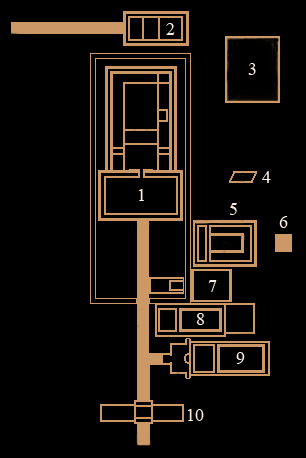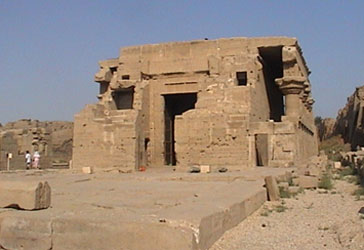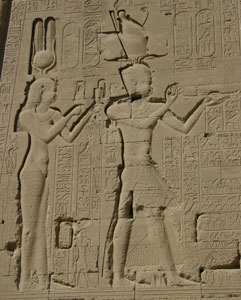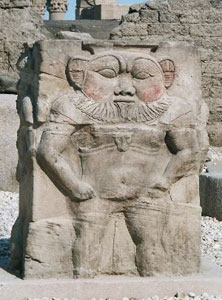The temple complex of Dendera (Denderah, Tentyra) is one of the best preserved complexes in Egypt. It lies around 2.5km south-east of Dendera (known to the ancient Egyptians as Iunet or Tantere) the sixth Nome of Upper Egypt. The whole complex extends to around 40,000 square metres and is surrounded by a large mudbrick enclosure wall.

There is evidence that the Old Kingdom pharaoh Pepi I built religious structures at the site and there are still remnants of a temple constructed during the eighteenth dynasty (during the New Kingdom). The latest additions to the site date to the Late Period.

- Temple of Hathor
- Temple of the birth of Isis
- Sacred Lake
- Well
- Sanatorium
- Chapel of Montuhotep
- Mammisi of Nectanebo II
- Christian Basilica
- Roman Mammisi
- Gateway of Domitian and Trajan
There are several kiosks from the Roman period outside the mudbrick enclosure wall which surrounds the temple complex. The gateway of Domitian and Trajan is built into this mudbrick wall and leads to a large open courtyard. There is, unusually, no colonnade or pylon gateway leading up to the temple of Hathor.

To the right of the gateway there is a Roman birth house (Mammisi) which is often ascribed to Trajan but may also have been constructed by Nero. The dedication inscriptions and decorations in the birth house refer to Trajan, but Nero is depicted inside the hypostyle hall of the temple of Hathor making an offering of a model of the birth house, implying that he was involved in its construction. This is the latest preserved birth house, and despite being built during the Roman period it largely follows the traditional Ptolemaic model.

In order to ensure that the birth house was level with the temple of Hathor it was built on a raised platform with an access stair at its side. In a break from tradition, the slabs which formed the roof were not positioned beneath the concave cavetto moulding which runs around the top of the walls. The inner sanctuary is divided into three corridors, but it is thought that the left and right corridors were symbolic and decorative as they are too narrow to be practical. There is a large false door set into the back wall of the sanctuary and a niche cut high into the wall, which corresponds to the location of the niche in the temple of Hathor, which would have held the cult statue.
The birth house was the ritual site of the birth of Ahy (Ihy) or Hor-sema-tawy (Harsomptus – “Horus the uniter of the two lands”) two youthful deities described as the sons of Hathor and Horus (or more specifically Horus of Behedet). The external walls feature beautiful representations of the divine birth and childhood of these deities. There are also numerous depictions of Bes (who was a patron of childbirth) on the capitals of the columns surrounding the birth house.

Beside this birth house can be seen the remains of a Coptic Christian basilica dated to the 5th century AD. Between the Coptic church and the temple of Hathor there is a smaller birth house which was built by Nectanebo I and further decorated in the Ptolemaic Period. This building was partly demolished in order to expand the courtyard in front of the temple of Hathor and only the false door and some decorations remain intact. The birth house was decorated with images of the Ptolemaic pharaohs making offerings to Hathor and of Khnum creating Ahy (Ihy) on his potter’s wheel under the watchful eye of Heqet in the form of a frog.
Further south, beside the temple of Hathor, there is a building known as the “sanatorium”. This building is apparently unique in Egyptian religion and architecture. The sanatorium was essentially a spa where the people could come to be cured by the goddess. There were sacred waters for bathing, sleeping quarters (where the sick would hope to gain the help of the goddess in their dreams) and the priests of Hathor operated an early pharmacy dispensing unguents and advising on cures. An inscription on the base of a statue implies that water was poured over the sacred texts inscribed on the statues and that this water could then cure a wide variety of ailments.
To the west of the sanatorium there was a small chapel built by Montuhotep Nebhepetre (during the eleventh dynasty) and featuring inscriptions referring to Merenptah (of the nineteenth dynasty). It is thought that this chapel was dedicated to the cult of the pharaoh rather than the goddess Hathor. The chapel has been dismantled and re-built inside the Cairo Museum.
It is believed that there were ancillary temples dedicated to Horus, and to their child Ihy and/or Hor sema-tawy within the temple complex, but these buildings have not survived.
Bibliography
- Bard, Kathryn (2008) An introduction to the Archaeology of Ancient Egypt
- Baines, John and Malek, Jaromir (1980) Atlas of Ancient Egypt
- Kemp, Barry (2005) Ancient Egypt: Anatomy of a civilisation
- Robins, Gay (1997) Art of Ancient Egypt
- Wilkinson, Richard H. (2000) The Complete Temples of Ancient Egypt
Copyright J Hill 2010